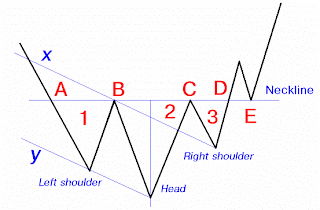tags:-Trend Reversal Patterns,Head-And-Shoulders,Inverse Head-And-Shoulders
Chart formations are generally sorted on the basis of their significance to the current trend of the underlying currency. Formations signaling the end of the trend are known as reversal patterns. Conversely, chart formations that confirm that the underlying currency trend is intact are called continuation patterns.
The most significant trend reversal patterns are:
1. Head-and-shoulders and inverse head-and-shoulders.
2. Double tops and double bottoms.
3. Triple tops and triple bottoms.
Head-And-Shoulders
The head-and-shoulders pattern is one of the most reliable and wellknown chart formations. It consists of three consecutive rallies. The first and third rallies—the shoulders—have about the same height, and the middle one—the head—is the highest. All three rallies are based on the same support line (or on the resistance line in the case of the reversed head-and-shoulders formation), known as the neckline.
Prior to point A, the neckline was a resistance line (see Figure 5.15.). Once the resistance line was broken, it turned into a significant support line. The price bounced off it twice, at points B and C. The neckline was eventually broken in point D, under heavy volume, and the trend reversal was confirmed. As the significant support line was broken, a retracement could be expected to retest the neckline (E), now a resistance line again. If the resistance line held, the price was expected to eventually decline to around level F, which was the price target of the head-and-shoulders formation. The target was approximately equal in amplitude to the distance between the top of the head and the neckline. The price target was measured from point D, where the neckline was broken. (See the dotted lines).
Signals Generated by the Head-and-shoulders Pattern
The head-and-shoulders formation provides excellent information:
1. The support line. This is based on points B and C.
2. The resistance line. After giving in at point D, the market may retest the neckline at point E.
3. The price direction. If the neckline holds the buying pressure at point E, then the formation provides information regarding the price direction: diametrically opposed to the direction of the head-and-shoulders (bearish).
4. The price target. This is provided by the confirmation of the formation (by breaking through the neckline under heavy trading volume).
 |
| Figure 5.15. Diagram of a typical head-and-shoulders pattern |
One of the main requirements of the successful development of this formation is that the breakout through the neckline occurs under heavy market volume. A breakout on light volume is a strong warning that it is a false breakout and will trigger a sharp backlash in the currency price. The time frame for this chart formation's evolution is anywhere from several weeks to several months. The intraday chart formations are not reliable. The longer the formation time is, the more significance should be attached to this pattern. The target is unlikely to be reached in a very short time frame. Whereas there is no immediate suggestion regarding the length of target reaching time, common sense would link it to the duration of development of the chart pattern.
It is reasonable to emphasize the importance of measuring the target from the point where the neckline was broken. There is a tendency among new technicians to measure the target price not only from under the neckline but also from the middle of the formation. This may happen as they measure the height of the head. Most head-and-shoulders formations, of course, look different from that in Figure 5.16. Prices fluctuate enough to forego any possibility of a clean-looking chart line. Also, the neckline is seldom a perfectly horizontal line.
 |
| Figure 5.16. Diagram of a typical inverse head-and-shoulders pattern |
Inverse Head-And-Shoulders
The inverse head-and-shoulders formation is a mirror image of the previous pattern. Therefore, you can apply the same characteristics, potential problems, signals, and trader's point of view from the preceding presentation. The underlying currency broke out of the downtrend ranged by the xx'-yy' channel. The currency retested the previous resistance line (the rally number 3), now turned into a support line. Among the three consecutive rallies, the shoulders (1 and 3) have approximately the same height, and the head is the lowest. Prior to point A, the neckline was a support line. Once this line was broken, it turned into a significant resistance line. The price bounced off the neckline twice, at points В and C. The neckline was eventually broken at point D, under heavy volume. As the significant resistance line was broken, a retracement could be expected to retest the neckline (E), now a support line again. If it held, the price was expected to eventually rise to around level F, which is the price target of the head-and-shoulders formation.
The price objective is approximately equal in amplitude to the distance between the top of the head and the neckline, and is measured from the breakout point D.
Do you like to read about Double Top and Double Bottom patterns click here and for Triple Top And Triple Bottom click here
Copyright (c)Tooklook.net and FOREX. On-line Manual For Successful Trading








0 comments:
Post a Comment